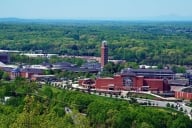You have /5 articles left.
Sign up for a free account or log in.
How could this happen in a library?
That was the question many students and alumni were asking Thursday after a gunman opened fire outside Florida State University’s Strozier Library, injuring three people before being shot and killed by police. Any campus shooting is a tragedy, but many at the university seemed particularly shaken because of where this one took place. “It made me nauseous hearing about the shooting at FSU library,” one alumna tweeted. “I used to study there every night and felt so safe."
The gunman was another Florida State alumnus, a 2005 graduate named Myron May who had since earned a law degree in Texas and recently returned to Tallahassee. May arrived outside the library around 12:30 Thursday morning and began shooting at students with a semiautomatic handgun, Michael DeLeo, chief of the Tallahassee Police Department, said in an afternoon press conference. May then entered the library, shot a library student-employee and reloaded his gun, before returning outside to face police. He did not attempt to go through the lobby's security turnstile, police said.
Police and the gunman fired more than 30 rounds at each other, DeLeo said. May's motive remains unclear, but police said that journals written by the gunman indicated that he was in a "state of crisis" and that he believed he was being "targeted" by the government. Two of the victims were hospitalized, including one who remained in critical condition Thursday.
At least 11 other shootings have taken place on college campuses in the last year, ranging from one-on-one student altercations to the mass violence that occurred at the University of California at Santa Barbara and, two weeks later, Seattle Pacific University. The number was even larger last year, with about two dozen shootings, but college students are actually much safer than similarly aged members of the general population, said Jen Day Shaw, associate vice president at the University of Florida and NASPA's Campus Safety Knowledge Community Chair.
“A shooting where three people are injured in a city might not even make headline news, but campus shootings draw a lot of attention," Shaw said. "And the reality is that many campuses are the size of cities. At the same time, historically we’re thought of as this super-safe ivory tower and, statistically, campuses are still pretty safe places.”
It’s important to remember that while studies indicate that mass shootings have become more frequent over the years, the average number of campus homicides has remained about the same, said S. Daniel Carter, director of 32 National Campus Safety Initiative, which is named for the 32 victims of the 2007 shooting at Virginia Tech.
“When you average it out, it has consistently been about 20 homicides a year,” Carter said. “So campus shootings are not the norm. Learning places are viewed as these havens where we send our young people, however, so it’s terrifying for students and parents to have that perception of safety challenged. Colleges are thought of as sanctuaries.”
And the center of those sanctuaries is often the campus library.
In a statement Thursday, John Thrasher, Florida State's new president, described the library as “the very heart of campus.” Journalist Adam Weinstein, a 2007 graduate of FSU who has since returned to the university as a Ph.D. candidate in creative nonfiction, wrote that “Strozier Library is as intrinsic to student life at FSU as Doak Campbell Stadium,” which is home to the university’s football team. Despite the late hour, more than 300 students were reportedly still inside the library when May started firing.
“Students spend a lot of time in libraries,” Shaw said. “That could make this a little more impactful, a little more scary. It’s an essential part of the fabric of their college experience. For many students, it’s almost the campus living room.”
But that doesn't mean libraries are any safer than the rest of campus. While they are not inherently dangerous places, campus safety experts said, libraries are often more open and easy to access than other buildings, particularly for people who do not attend or work at the college. Classroom buildings may close at a certain hour and dormitories may require key cards, but a key feature of a 24-hour library at a public university (like Strozier) is its openness.
Many colleges in recent years have increased violence prevention efforts, including improved mental health services for students, but it is difficult to prepare for a campus threat that has little or no current connection to an institution. More accurately, the task may be impossible, said William Taylor, president-elect of the International Association of Campus Law Enforcement Administrators.
“There may be some after-hours restrictions or identification requirements, but larger colleges have so many people coming and going in their libraries and they are often big buildings,” Taylor said. “Libraries are big and open places on what are already big and open spaces. Campuses are usually wide-open to the environments around them. They’re like shopping malls or movie theaters in that way. You cannot predict somebody coming from the outside. There is absolutely no way to prepare for it.”
Instead, Taylor said, campus police and security officers have to be ready to respond as quickly as possible. Many praised the prompt response of FSU and Tallahassee officers Thursday. According to university police chief David Perry, the entire sequence of events – from the first report of the gunman to police shooting and killing him – lasted only about two minutes. The gunman never made it farther than the lobby.
“I think it was a fantastic response,” Taylor said. “It’s an unfortunate thing when it happens, but the more of these that have occurred, the more training we do as public safety officers, and the better we get at responding.”
Carter said this sort of response may not have been possible a few years ago – especially not before the shooting at Virginia Tech, which he said galvanized many colleges to become better prepared for campus violence.
“It's tragic that Mr. May lost his life, but we’re making progress,” he said. “And we have to. It is our obligation to make something good come from these tragedies. It is our obligation to make our campuses safer. I think FSU’s response could be example number one of the lessons we’ve learned since 2007 in how you alert people when there’s an immediate threat and how you respond. It means we’re learning and that the 32 innocent lives lost at Virginia Tech were not lost in vain.”
At a press conference Thursday, Thrasher also praised the actions of police -- and told students the campus would try its best to "get back to normal." The library, he said, will reopen Friday morning.








